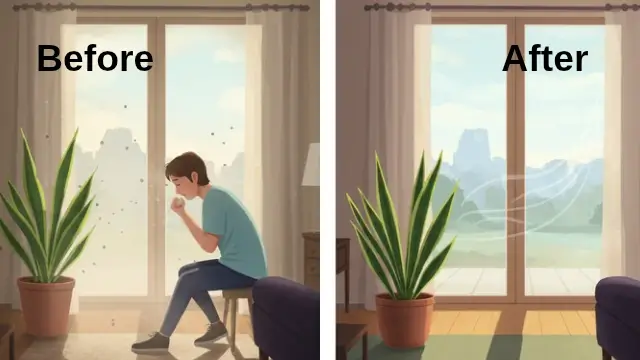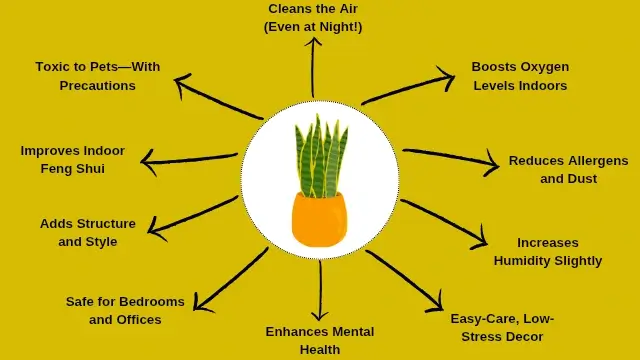If you’re wondering what a snake plant does for your house, here’s the short answer:
Snake plants purify indoor air, boost oxygen levels, reduce allergens, and enhance your home’s ambiance with low-maintenance beauty—all while improving your mental well-being.
Simple, right? But let’s break down how this seemingly humble houseplant pulls off such impressive feats.
1. Cleans the Air (Even at Night!)
Snake plants have gained recognition for their role in enhancing indoor air quality through natural filtration. Unlike most plants, Sansevieria trifasciata performs photosynthesis through a method called Crassulacean Acid Metabolism (CAM), allowing it to absorb carbon dioxide and release oxygen at night (1). This makes it perfect for bedrooms or small offices with poor ventilation.
It also removes airborne toxins such as:
- Benzene
- Formaldehyde
- Trichloroethylene
- Xylene
According to NASA’s Clean Air Study, snake plants were among the top performers for removing indoor air pollutants (2).
2. Boosts Oxygen Levels Indoors
Thanks to their CAM photosynthesis process, snake plants are able to release oxygen even during nighttime hours. Adding a few snake plants to your bedroom may improve sleep quality and reduce that stuffy, heavy indoor feeling (1). While they won’t replace a HEPA filter, they certainly add a natural boost.
3. Reduces Allergens and Dust
Snake plants help trap dust and airborne particles on their wide, waxy leaves. This passive filtering can improve the air quality for people with mild respiratory issues, seasonal allergies, or sensitivities to dry indoor air.
In my own experience, placing a few snake plants around the house noticeably reduced my sneezing during spring allergy season.

4. Increases Humidity Slightly
While snake plants aren’t the most efficient humidifiers, they still contribute some moisture to the air through transpiration. In dry indoor environments (especially in winter or with heaters running), every bit helps.
Indoor plants provide many benefits beyond just aesthetics. According to Dr. Leonard Perry, horticulture Professor Emeritus at the University of Vermont, plants in homes and workplaces can reduce stress, increase productivity, enhance moods, and contributes to better air conditions. They also help regulate temperature and humidity through the process of transpiration, releasing moisture that supports comfortable indoor humidity levels. This can reduce respiratory discomfort and help prevent materials like wood from cracking due to dryness (3).
5. Easy-Care, Low-Stress Decor
Let’s be honest—plants that require daily attention can quickly become overwhelming. The snake plant is famous for thriving on neglect. It tolerates:
- Low light
- Infrequent watering
- A wide range of temperatures
That makes it ideal for beginners or anyone with a busy lifestyle. For me, it was the first plant I didn’t accidentally kill within a month.
6. Enhances Mental Health
Bringing nature indoors has proven psychological benefits. Scientific findings suggest that indoor plants may help alleviate stress, elevate mood, and enhance work efficiency (4).
Whenever I feel anxious or mentally cluttered, a quick plant-care moment with my snake plant often centers me. It’s a quiet reminder to slow down.
7. Safe for Bedrooms and Offices
Thanks to its night-time oxygen production, snake plants are especially useful in places where people spend a lot of time breathing stale air—like:
- Bedrooms
- Small apartments
- Dorm rooms
- Offices
Just one medium-sized snake plant per 100 square feet can make a noticeable difference in air freshness (1).
8. Adds Structure and Style
Snake plants offer a bold and upright silhouette that complements contemporary interior design schemes. Whether you go for a classic variety or a rare cultivar, the bold vertical shape fits minimalist, boho, or Scandinavian aesthetics.
Snake plants pair well with:
- Clay or matte ceramic pots
- Wooden plant stands
- Macramé hangers
9. Improves Indoor Feng Shui
In Feng Shui, the snake plant is often recommended to protect against negative energy when placed in specific areas of the home. While not a scientific benefit, many plant lovers (myself included) enjoy the intentionality it brings.
Strategically placing it near doorways or corners is said to deflect stagnant energy and bring in protective, grounding vibes.
10. Toxic to Pets—With Precautions
Snake plants (Sansevieria trifasciata) are toxic to both cats and dogs if ingested, according to the ASPCA (5). This plant contains naturally occurring saponins—chemical compounds that may lead to digestive upset such as nausea or vomiting if pets ingest them. Reactions can vary depending on the quantity consumed and the animal’s size.
If you suspect your pet has chewed on a snake plant, contact your veterinarian or the ASPCA Animal Poison Control Center at (888) 426-4435 immediately.
That said, many pet owners still grow snake plants safely by keeping them out of reach—on high shelves, in hanging planters, or in off-limits rooms. Always assess your pet’s behavior before bringing one into your home.
Bonus: Snake Plants Multiply Easily
Snake plants don’t just bring benefits—they bring babies. If your snake plant is thriving, it may produce pups (baby shoots) you can propagate.
I’ve grown over 7 new plants from one original mother plant with just a sharp knife and some patience. Learn the exact methods in our snake plant propagation tutorial.
This means more greenery at no extra cost—and more air-purifying goodness.
Final Thoughts

So, what does a snake plant do for your house?
A lot more than people expect. From purifying air to lifting your mood, it’s an understated hero in any indoor space. It’s low-maintenance, stylish, and scientifically backed. Whether you’re a plant newbie or a seasoned collector, the snake plant is a must-have.
Wondering how snake plants stack up against other air plants? Explore our detailed air plant comparisons to find your perfect match.
References
- Kumar, A., & Pandey, V. (2014). CAM Photosynthesis: Importance and Biological Significance. Journal of Plant Biology,
- Wolverton, B. C., Johnson, A., & Bounds, K. (1989). Interior Landscape Plants for Indoor Air Pollution Abatement. NASA Clean Air Study,
- Perry, L. (2018, updated 2020). Indoor plants provide many benefits. VTCNG Special Publications. University of Vermont
- Bringslimark, T., Hartig, T., & Patil, G. G. (2009). The psychological benefits of indoor plants: A critical review of the experimental literature. Journal of Environmental Psychology,
- ASPCA Animal Poison Control. Sansevieria trifasciata. Toxic and Non-Toxic Plants List,

